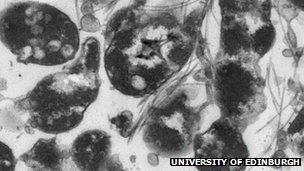Asteroid craters could provide clue to life on Mars
- Published

The chances of finding life on Mars could be improved by looking in craters made by asteroids, according to a study.
Scientists at the University of Edinburgh said organisms had been discovered thriving deep underneath a site in the US where an asteroid crashed 35 million years ago.
They believe such craters provide refuge for microbes.
The findings suggest that crater sites on other planets may be "hiding life".
To find the microbes, researchers drilled almost 2km below one of the largest asteroid impact craters on Earth, in Chesapeake, US.
Samples from below ground showed that microbes are unevenly spread throughout the rock, suggesting that the environment is continuing to settle 35 million years after impact.
Researchers from the University of Edinburgh said heat from the impact of an asteroid collision would kill everything at the surface, but fractures to rocks deep below would allow water and nutrients to flow in and support life.
They believe asteroid craters provide shelter to microbes, shielding them from the effects of changing seasons and events such as global warming or ice ages.
Prof Charles Cockell, from the University of Edinburgh, said: "The deeply fractured areas around the impact craters can provide a safe haven in which microbes can flourish for long periods of time.
"Our findings suggest that the subsurface of craters on Mars might be a promising place to search for evidence of life."
- Published26 November 2011
- Published8 December 2009